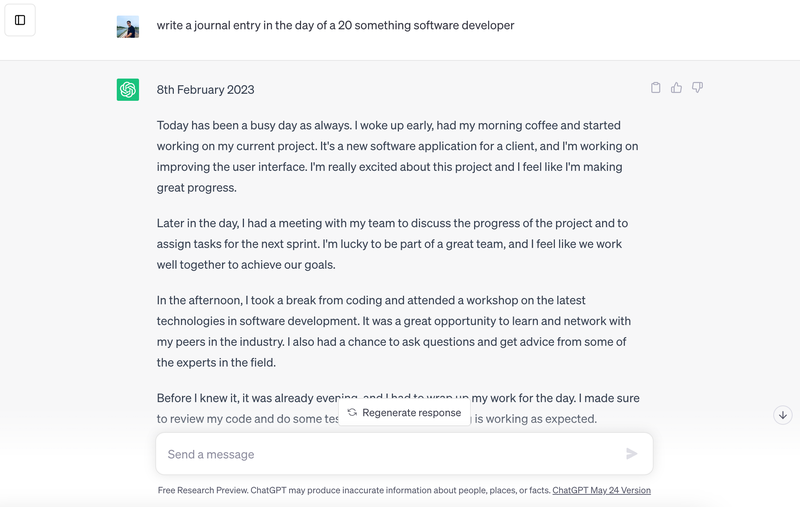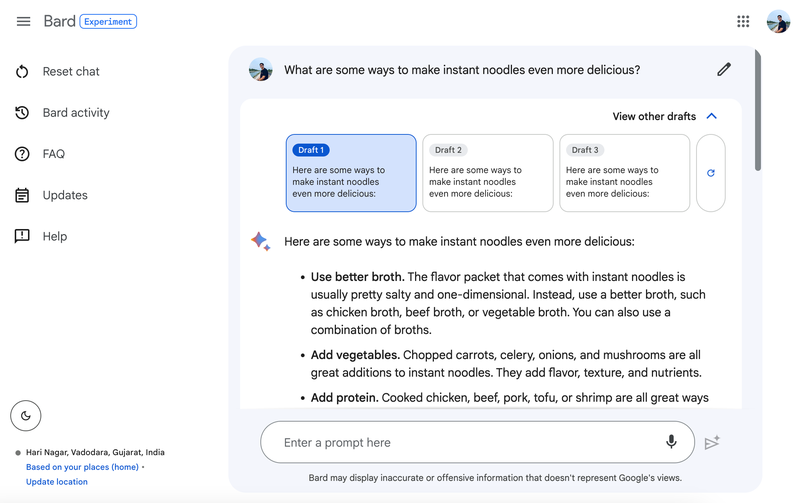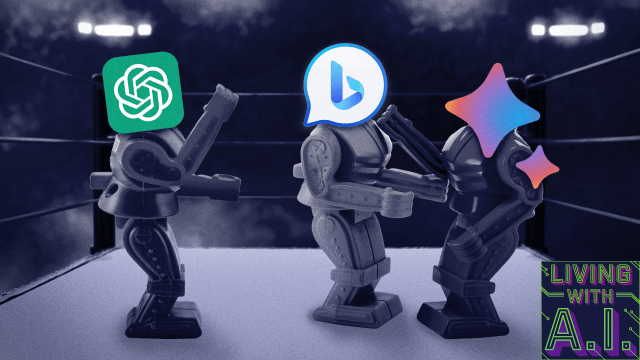This post is part of Lifehacker’s “Living With AI” series: We investigate the current state of AI, walk through how it can be useful (and how it can’t), and evaluate where this revolutionary tech is heading next. Read more here.
If you’re looking to try out AI for yourself, it seems there’s no clear place to start. Everyone is already talking about OpenAI’s ChatGPT, of course, but that’s only one of the available options. In addition to ChatGPT, there’s Microsoft’s Bing Chat, which is powered by ChatGPT’s underlying technology; and Google Bard, which is trying to do its own thing.
They all seem similar on the surface, but they each have their pros and cons (some more than others). Let’s take a look at each, and see which one you should be using for what.
ChatGPT, the big sensation

If you’re looking to try out an AI chatbot, ChatGPT is still a great place to start. It has a simple interface, with your current chat in the main window and all past chats neatly stored in the left sidebar. You can get started with a free account, which gives you access to the GPT 3.5 large language model. While it has the tendency to hallucinate (something that’s common with all the apps listed here), it does a good job giving you answers and solutions on things it’s trained to do.
I’ve used it for, gosh, so many things, like coming up with travel plans, asking for book recommendations, summarizing articles, and even some simple coding samples—everything short of a Google search.
And if you’re willing to pay for ChatGPT Plus, you can get access to the GPT-4 model, the latest iteration of OpenAI’s LLM. GPT-4 is faster, more reliable, and always available, as the free website suffers from frequent wait times. It also includes support for plugins so you can do things like connect to the web (something that ChatGPT couldn’t previously do) and link other apps to perform automated tasks. For example, you can use the Kayak plugin to ask ChatGPT for hotel recommendations and book a room, or the OpenTable plugin to ask the chatbot to find great restaurants in your area.
Once you sign up for OpenAI’s pay-as-you-go plan and activate your API key, you’ll realize that ChatGPT actually isn’t simply a website: Your API key will let you add ChatGPT to many different apps and services. Add it to a Chrome extension to summarize articles faster, to any app that supports features powered by the GPT API, or to chat with ChatGPT without even opening the site.
Bing Chat is a better co-pilot for the web
Bing Chat is integrated right in the Microsoft Edge browser, and by default, it only works in Edge. (You can use workarounds, however.) It’s built using the same technology as ChatGPT. In fact, Bing Chat gives you access to GPT-4, and internet search (plus upcoming plugins support) for free, undercutting ChatGPT Plus’s monthly cost.
Though the technology is the same, and you can do many of the same things in Bing Chat as you can on ChatGPT, there is one huge difference between the two services: how you use it.
Bing Chat is designed to be a co-pilot while you’re browsing the web. Click the Bing Chat button in Edge and start asking it questions about the website you’re currently on, or about anything in general. You can ask it to write recipes, code samples, summarize articles, and so on. It can even summarize long PDF documents for you.
Because Bing Chat integrates with Bing Search, you can go a step further and ask it questions about current events. It will give you a concise report and provide links to sources as well (something that ChatGPT won’t do right now). Of course, this is all still working from the GPT model, which means Bing Chat can also hallucinate, so always refer to the source link to double-check.
Bing Chat has a separate interface called Compose, where you can give it a prompt and ask it will write, well, anything you want. And because it integrates with DALL·E, you can even use Bing Chat to generate images.
While Bing Chat is free, Microsoft doesn’t grant you unlimited access. At the time of writing, the company has limited Bing Chat use to 30 chats per session and 300 chats in a day. That should be plenty, honestly, but it’s something to be mindful of. (You’ll be reminded of your usage stats in the chat box.)
Google Bard is free, with fast access, and no catches

Google has been playing catchup since ChatGPT first released, and in many ways, Bard is the distant third in this consumer AI chatbot battle. That doesn’t mean it’s a bad product, though. In fact, Bard has a lot going for it that the ChatGPT-based tools don’t.
First of all, Bard is free to use, loads up instantly, doesn’t have long loading times, and puts no limits on queries. Given how processor-intensive generative AI is, these are all great feats.
Bard is also taking baby steps towards becoming a fully-fledged product. (If you had any doubt it’s not there yet, it has a big “Experiment” tag right up top.) It doesn’t have the best track record for web search accuracy, and it will outright lie to you—again, hallucinations are a real problem for AI—but it has some unique skills of its own: You can use your voice to search, and Bard will let you export generated content directly to Gmail or Google Docs.
Google Bard is also transparent in its generative attempts. It’s the only service that shows you different drafts of answers, letting you pick between them. Bard’s current model is nothing to write home about, as it frequently fails basic math questions and internet queries, but Google is rapidly developing the product, and its upcoming PaLM 2 model promises improvements in math, coding, and language issues. Plus, Bard is already popping up everywhere across Google’s suite of products (Gmail, Workspace, and more). It even integrates with Adobe Firefly to generate images.
As it stands, Google Bard is good at some basic things, and it can help you generate decent-sounding prose, but its best days clearly still lie ahead. Google might be able to claim victory over the competition once it both improves its AI and naturally integrates it with the products millions of people use every day. Until then, feel free to continue using ChatGPT.

Leave a Reply
You must be logged in to post a comment.